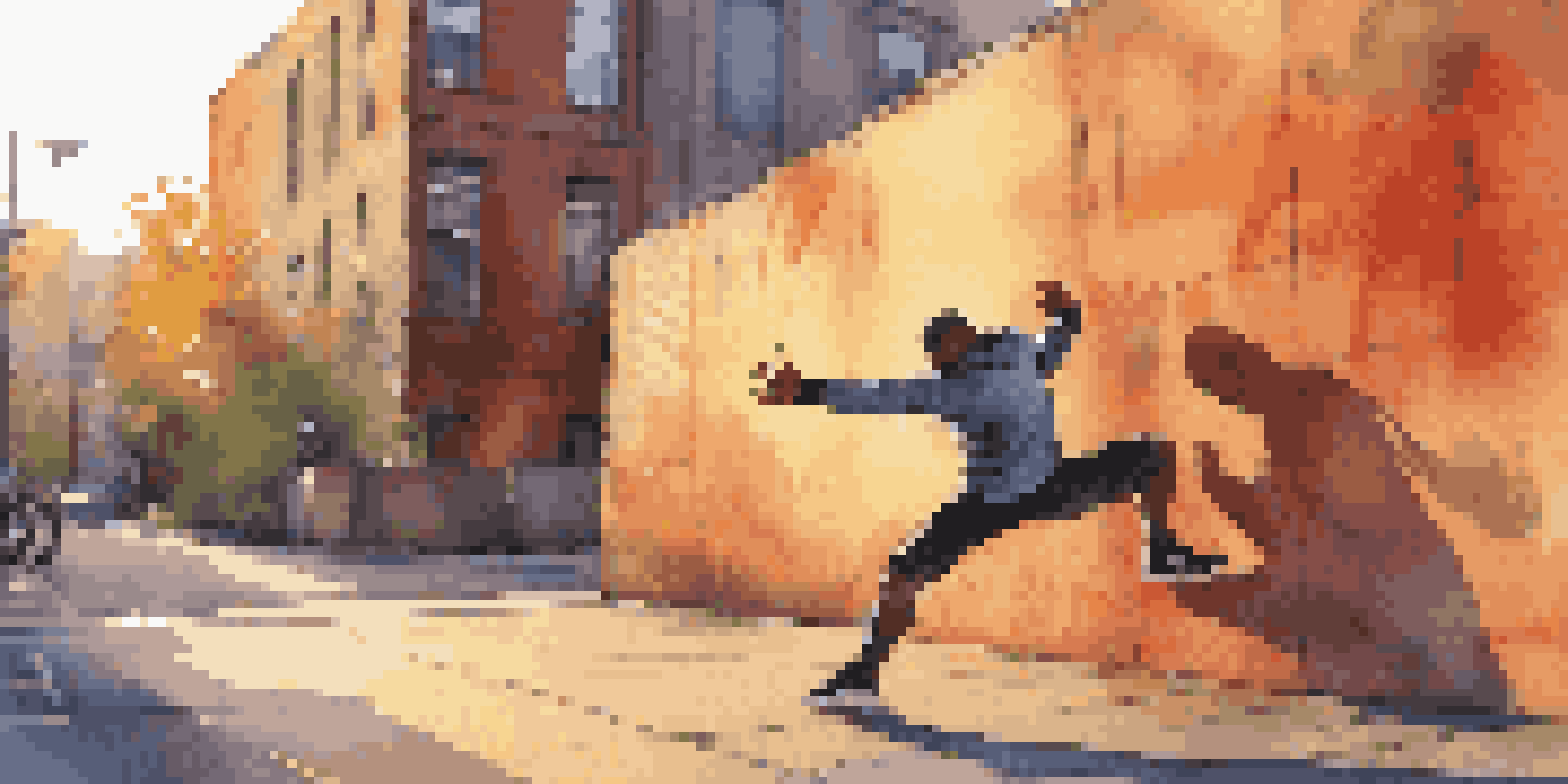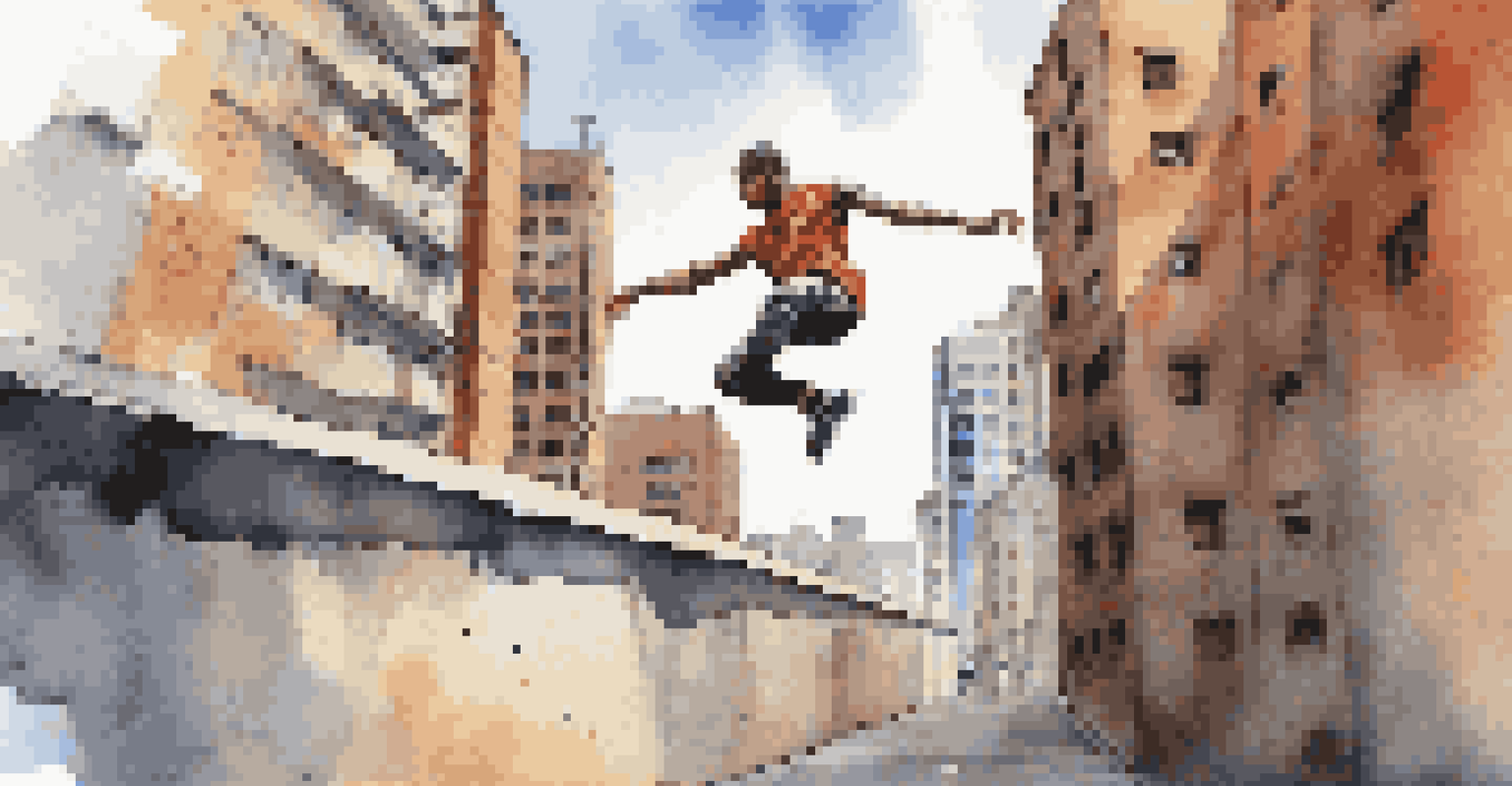Common Parkour Mistakes and How to Avoid Them

Neglecting Proper Warm-Up and Stretching Routines
One of the most common mistakes in parkour is skipping warm-ups and stretching. Just like a car needs to warm up before hitting the road, your body needs to prepare for the physical demands of parkour. Neglecting this crucial step can lead to injuries, making it harder to practice and progress.
The only real mistake is the one from which we learn.
A proper warm-up increases blood flow to your muscles and enhances flexibility, reducing the risk of strains. Think of it this way: would you dive into a cold pool without first easing in? By incorporating dynamic stretches and light cardio, you’ll set yourself up for a smoother, safer training session.
To avoid this mistake, allocate at least 10-15 minutes before your parkour practice for a thorough warm-up. This habit not only protects your body but also improves your overall performance.
Trying Advanced Moves Before Mastering Basics
Jumping straight to advanced parkour moves can be tempting, but it’s a recipe for disaster. Much like building a house, you need a strong foundation before adding the roof. If you attempt complex techniques without mastering simpler ones first, you increase your risk of injury while hindering your overall progress.

Take the time to develop your basic skills, such as rolls, landings, and vaults. These foundational movements are crucial not just for safety, but they also improve your confidence as you tackle more challenging obstacles. Remember, even the best athletes started with the basics!
Warm-Up and Stretch for Safety
Neglecting proper warm-up and stretching routines can lead to injuries and hinder your progress in parkour.
By focusing on mastering the fundamentals, you’ll create a solid skill set that will support your growth in parkour. Patience and practice now will pay off in the long run.
Ignoring Personal Limits and Physical Conditioning
Every individual has unique strengths and limitations, but many parkour practitioners overlook their own physical conditioning. It’s essential to understand your body’s capabilities and not push beyond them too quickly. Ignoring your limits can lead to serious injuries that may sideline you for weeks or even months.
Take care of your body. It's the only place you have to live.
To build a sustainable parkour practice, listen to your body and respect its signals. If you're feeling fatigued or in pain, it’s best to take a step back rather than risk further injury. Just like a marathon runner respects their endurance, you should honor your body’s needs.
Incorporate strength and conditioning exercises into your routine to build resilience and improve your parkour skills. This way, you’ll be prepared to tackle challenges without compromising your safety.
Neglecting Safety Gear and Environment Awareness
Safety gear is often an afterthought for many parkour enthusiasts, but it plays a vital role in injury prevention. While it might feel like a hassle to don pads and helmets, they can be lifesavers when you’re learning new skills. Think of them as your safety net; they allow you to explore your limits without fear of severe injuries.
Additionally, being aware of your surroundings is crucial. Look for potential hazards like uneven surfaces, sharp edges, or other obstacles that could pose risks during practice. Just as a driver scans the road for safety, you should scan your environment before attempting a move.
Master Basics Before Advancing
Focusing on mastering basic skills is crucial for safety and confidence as you progress to more advanced parkour moves.
To minimize risks, always wear appropriate safety gear and conduct a quick assessment of your practice area. By prioritizing safety, you’ll enjoy parkour much more and progress faster.
Failing to Learn from Mistakes and Setbacks
Mistakes and setbacks are a natural part of any learning process, including parkour. However, many practitioners fail to reflect on their experiences, which can stall their progress. Instead of viewing these moments as failures, think of them as valuable lessons that can help you grow.
When you stumble or fall, take a moment to analyze what went wrong and how you can improve next time. Perhaps you misjudged a jump or didn’t land correctly. By understanding the cause of your mistakes, you can adjust your technique and approach.
Embrace a growth mindset and view challenges as opportunities to learn. This perspective shift can significantly enhance your parkour journey and keep you motivated to push forward.
Overlooking the Importance of Recovery and Rest
In the pursuit of mastering parkour, many forget the significance of recovery and rest. Just like a smartphone needs to recharge, your body requires time to heal and rebuild after intense training. Ignoring rest can lead to burnout or chronic injuries, which can derail your progress.
Incorporating rest days into your training schedule is essential for long-term success. These breaks allow your muscles to recover and grow stronger, ultimately improving your performance. Remember, rest isn’t a sign of weakness; it’s a strategic part of your training plan.
Embrace Recovery and Community
Prioritizing recovery and seeking guidance from a supportive community can enhance your parkour journey and improve performance.
To optimize your recovery, consider practices like yoga, stretching, and proper nutrition. By prioritizing recovery, you’ll not only feel better but also be more prepared for your next training session.
Not Seeking Guidance or Community Support
Trying to navigate the world of parkour alone can be daunting. Many practitioners may feel shy about asking for help or guidance, but doing so can significantly enhance your learning experience. Just like in any sport or activity, having a supportive community can provide valuable insights and motivation.
Consider joining a local parkour group or finding online communities where you can share experiences and learn from others. Watching seasoned practitioners can inspire you and help you identify areas for improvement in your own technique. Plus, training with others makes it more fun!

Don’t hesitate to seek out coaches or mentors who can provide personalized feedback. With the right support, you’ll progress more quickly and enjoy the journey even more.